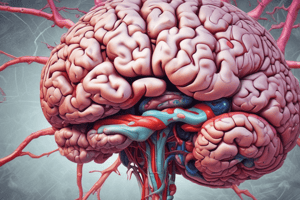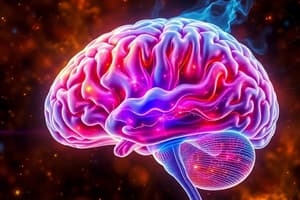Podcast
Questions and Answers
Which part of the brain stem lies directly superior to the medulla oblongata?
Which part of the brain stem lies directly superior to the medulla oblongata?
- Cerebellum
- Pons (correct)
- Thalamus
- Midbrain
What is the function of the superior colliculi in the midbrain?
What is the function of the superior colliculi in the midbrain?
- Temperature regulation
- Auditory processing
- Taste perception
- Visual processing (correct)
Which part of the brain regulates vital activities such as the cardiovascular and medullary respiratory centers?
Which part of the brain regulates vital activities such as the cardiovascular and medullary respiratory centers?
- Occipital lobe
- Hypothalamus
- Cerebellum
- Medulla oblongata (correct)
What is the function of the nuclei in the medulla oblongata?
What is the function of the nuclei in the medulla oblongata?
Which part of the brain stem is responsible for controlling breathing through its respiratory center?
Which part of the brain stem is responsible for controlling breathing through its respiratory center?
What is the structure that connects the two hemispheres of the cerebellum?
What is the structure that connects the two hemispheres of the cerebellum?
Which gland, located in the epithalamus, produces melatonin to help regulate sleep?
Which gland, located in the epithalamus, produces melatonin to help regulate sleep?
What is the function of basal nuclei within the brain?
What is the function of basal nuclei within the brain?
Which part of the brain is known as the 'seat of intelligence'?
Which part of the brain is known as the 'seat of intelligence'?
What is located posterior to the cerebral peduncles in the midbrain?
What is located posterior to the cerebral peduncles in the midbrain?
Flashcards are hidden until you start studying
Study Notes
Brain Stem
- Consists of three areas: medulla oblongata, pons, and midbrain
- Medulla oblongata: continuous with the superior part of the spinal cord, contains sensory and motor tracts, and regulates vital activities
- Medulla oblongata features:
- Pyramids containing motor tracts with decussation (crossing of neurons)
- Nuclei that regulate vital activities, such as cardiovascular and respiratory centers
- Controls swallowing, coughing, vomiting, sneezing, and hiccupping
Pons (Bridge)
- Lies directly superior to the medulla oblongata
- Contains a respiratory center to help control breathing
- Associated with several cranial nerves
Midbrain
- Extends from the pons to the diencephalon
- Divided into two parts: cerebral peduncles (motor tracts) and the tectum (corpora quadragemina)
- Features:
- Superior colliculi for vision
- Inferior colliculi for audition
- Reticular formation: a netlike arrangement with gray and white matter, involved in maintaining consciousness and detecting light, touch, pain, but not temperature and smell
Cerebellum
- Consists of two hemispheres united by the vermis
- Features:
- White matter called arbor vitae
- Gray matter called folia
- Coordinates skeletal muscle contractions
Diencephalon
- Composed of the thalamus, hypothalamus, and epithalamus
- Hypothalamus:
- Controls the endocrine system
- Regulates body temperature, thirst, hunger, and autonomic tone
- Maintains balance
- Epithalamus:
- Mostly consists of the pineal gland, which produces melatonin
Cerebrum
- The largest part of the brain, considered the "seat of intelligence"
- Divided into an outer cerebral cortex and internal white and gray matter
- Features:
- Cerebral cortex: made of gray matter with grooves (sulci) and ridges (gyri)
- Central sulcus dividing the frontal and parietal lobes
- Longitudinal fissure separating the right and left hemispheres
- Transverse fissure separating the cerebrum and cerebellum
- Divided into lobes: frontal, parietal, occipital, and temporal
- White matter consists of myelinated axons in three tracts: association, commissural, and projection tracts
- Basal nuclei: collections of gray matter deep within the white matter, involved in involuntary skeletal muscle movement
- Limbic system: a collection of structures involved in emotion and memory
Studying That Suits You
Use AI to generate personalized quizzes and flashcards to suit your learning preferences.




